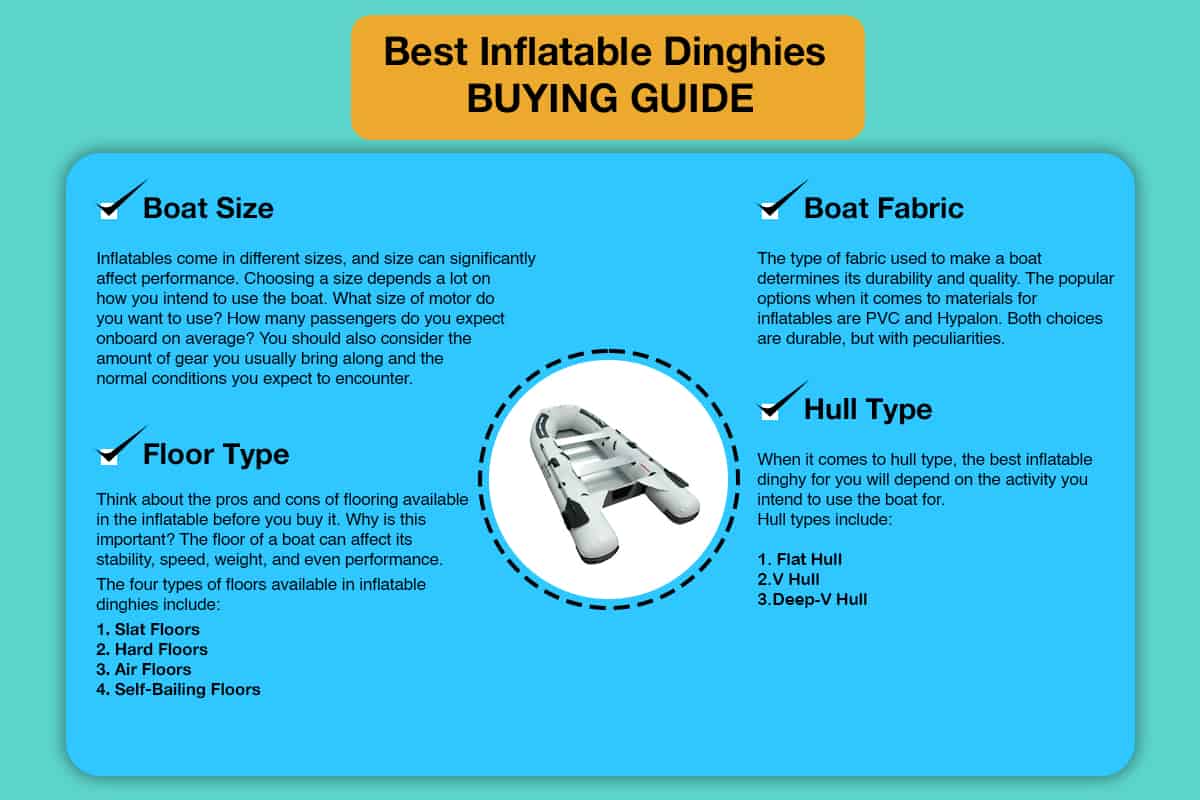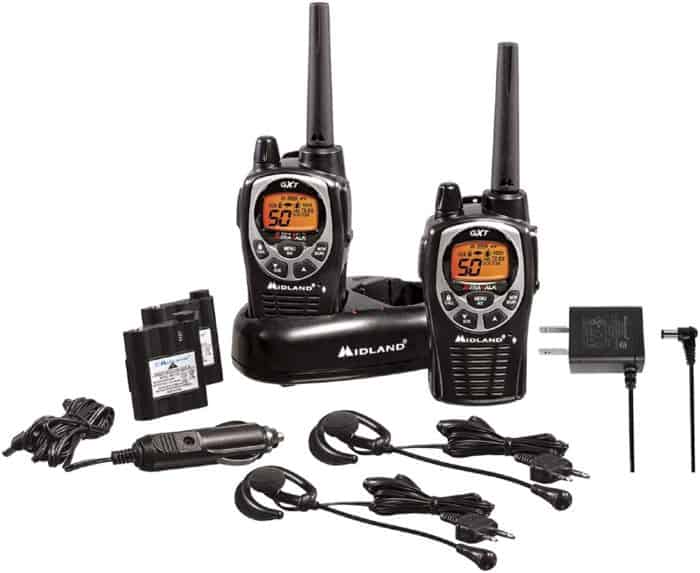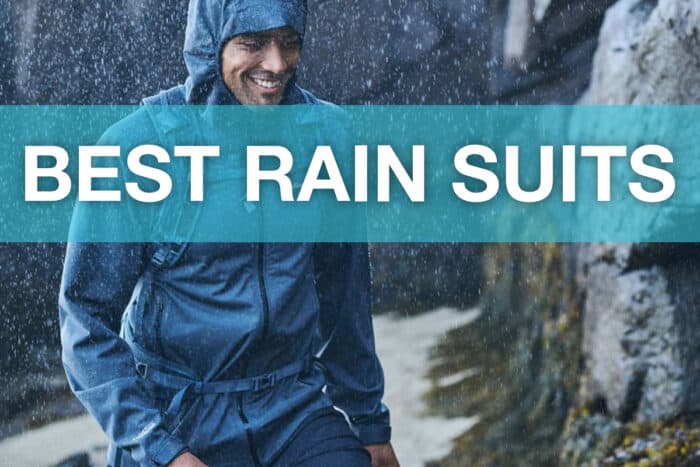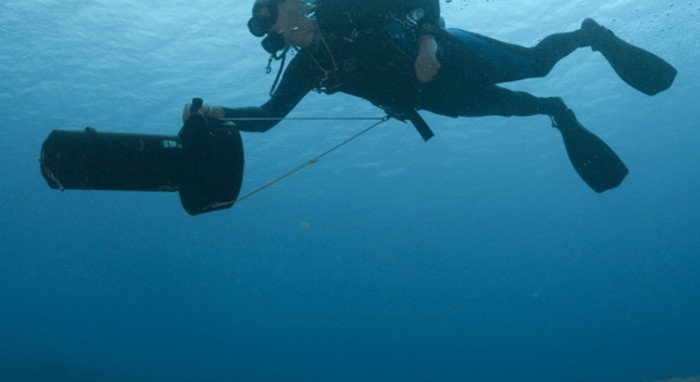Best Inflatable Dinghies of 2024 Reviewed
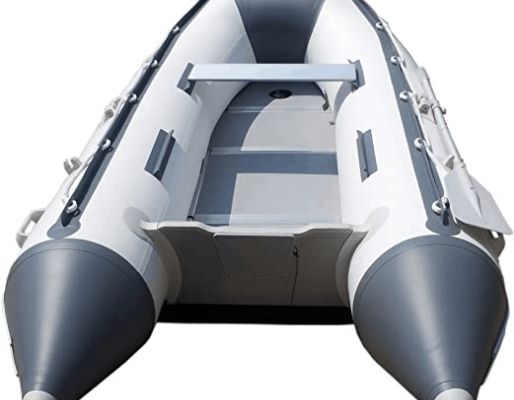
Newport Vessels Dana
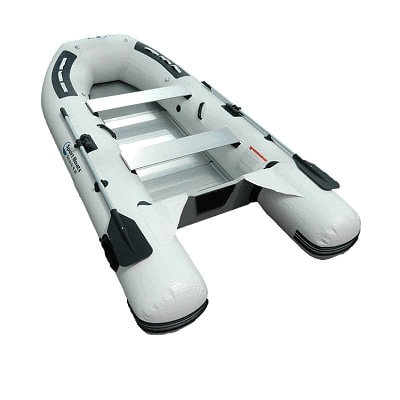
Sport Boats Killer Whale
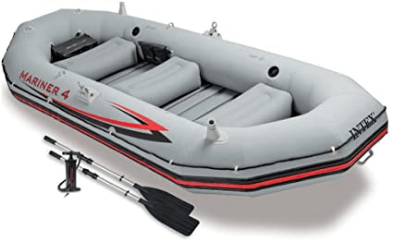
Intex Mariner 4
A traditional boat is priceless to anglers and boaters, but it comes with the problem of finding suitable storage and trailer. This translates to increased costs that might not be too appealing for some intending boaters.
Thankfully, an inflatable dinghy offers all the functions of a traditional boat plus convenience, high performance, ease of use, and safety. You don’t need a trailer to lug most inflatables from place to place. And you definitely don’t need dock rentals or spend extra money on storage for these boats.
However, choosing the best inflatable dinghy is usually not a walk in the park, particularly if it is your first time doing so. For this reason, we’ve reviewed the top 5 options available on the market to ease your buying decision. We’ve also included a detailed guide to help select the best type that suits your purpose.
Newport Vessels Dana

Let’s kick things off with a boat that combines near-perfect performance with portability. From Newport Vessels comes Dana, a special 8-feet inflatable sport tender dinghy boat with large tubes that resembles twin rockets. It seats up to three passengers and can take up to 1,067 lbs.
This boat might be just the right one for you if you’re looking for a dinghy with remarkable speed, superior stability, and durable construction material. With a hull made from 1100 Denier Korean PVC, this boat can survive rough water adventures.
A 30-day money-back guarantee backs your purchase. There’s also a 2-year manufacturer warranty, so you can be sure that your investment will not go to waste in case something goes wrong.
Specs
- Weight: 107 lbs
- Number of Chambers: 4
- Passenger Capacity: 3 people
- Load Capacity: 1,067 lbs
- Engine Capacity: 10 HP
- Fabric: UV coated PVC
- Warranty: 2 years (30-day return policy)
Features
- Built-in Options: Self-bailing drain plug, grab rope, carrying handles, and three bow D-rings for towing.
- Accessories: Carry bag, two aluminum oars, and foot pump.
Pros
• Considerably large tubes and marine wood floor increases stability
• Easy to fold and carry
• Increased speed
Cons
• Large tube size takes away from the cockpit room
• Oarlocks might not fit aftermarket equipment due to small size
Sport Boats Killer Whale

Not a lot of inflatables pack the power that comes with the Killer Whale from Sport Boats. Although it can take a load of more than 1,200 lbs or five adults, it can still glide through the water seamlessly, thanks to its extended rear pontoons.
Maneuvering this dinghy is easy-breezy due to its contoured design. The boat is constructed with a 9 mm reinforced PVC hull and has a slide-in aluminum floor. This is the perfect dinghy for fresh and saltwater activities.
You’re going to need some help transporting this one, though. At 10 feet 8-inches, the Killer Whale is not particularly a small boat.
Specs
- Weight: 80 lbs
- Number of Chambers: 3
- Passenger Capacity: 5
- Load Capacity: 1,268 lbs
- Engine Capacity: 15 HP
- Fabric: 1100 reinforced PVC material
- Warranty: 3 years
Features
- Built-in Options: Two oarlock-in holders, five carrying handles, and two towing rings.
- Accessories: Carry bag, one aluminum bench, two aluminum oars, foot pump, and removable seat cushions.
Pros
• Suitable for a variety of application in saltwater and freshwater
• Increased outboard support and planning due to extended rear pontoons
• Comes with plenty of extras
• Assembly takes roughly 10 minutes
Cons
• Heavy boat, making it difficult to transport than other models
Bris Fish Hunter Boat
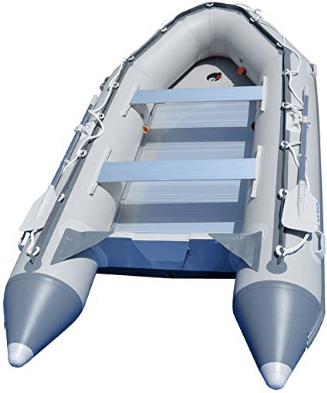
Here’s something for those searching for the best inflatable dinghy that works for commercial and recreational purposes. The Bris Fish Hunter Boat may have the same appearance as the other options, but as they say, don’t judge a book by its cover.
This one is built to be rugged. With an outboard to support 25 horsepower and heavy-duty construction, the boat delivers exceptional performance than most models.
It is extremely stable, and the additional aluminum floor panels provide maximum support. Constructed with a thick 2000 Denier PVC material, the heavy-duty fabric can withstand tension, tears, and other hazards.
Specs
- Weight: 150 lbs
- Number of Chambers: 3
- Passenger Capacity: 6 adults
- Load Capacity: 1,675 lbs
- Engine Capacity: 25 HP
- Fabric: PVC (with polyester support)
- Warranty: 3 years (30-day money-back guarantee)
Features
- Built-in Options: Safety ropes, interior tie-downs, oarlock, D-rings, drain valves, handles, and splash guard.
- Accessories: Carry bag, two aluminum bench, two oars, foot pump, aluminum floor panels, and repair kit.
Pros
• Superior maximum horsepower
• Includes aluminum floor panels to support seats
Cons
• Heavy boat, making transportation difficult for a single-user
Intex Mariner 4

For those who are on the fence about inflatable dinghies, Intex Mariner 4 is an excellent way to test the waters. It is also the perfect boat for those on a budget.
Although this is an inexpensive option, it doesn’t take away from its high-quality, durability, and performance. The Intex Mariner 4 is built to convey four people without straining under the weight. The rigid plastic floor improves the boat’s overall stability and provides for a more stable standing platform for occupants.
The durable PVC construction protects the boat against abrasion, puncture, spilled fuel, and other hazards.
Carrying this boat around is quite easy due to its multiple handles. Don’t have a large space in your car’s trunk? No worries. The 10 feet 9 inches inflatable dinghy will roll up and fit into the trunk of any small passenger car once deflated.
Specs
- Weight: 77 lbs
- Number of Chambers: 4
- Passenger Capacity: 4 adults
- Load Capacity: 1,100 lbs
- Engine Capacity: 3 HP gas or 55 lb. thrust electric
- Fabric: PVC (triple layer of super tough material)
Features
- Built-in Options: Four valves, two fishing rod holders, oar holders, grab handles, three inflatable seats, motor mount, and rotational oarlocks.
- Accessories: Carry bag, high output pump, two 54-inch aluminum oars, and a repair patch kit.
Pros
• Ease of transportation and storage
• Increased stability due to inflatable keel and hard plastic floor
• Affordable
Cons
• Comparatively low maximum horsepower rating
• Little room for gear
• Carry bag might not be durable
Sea Eagle Stealth Stalker STS10
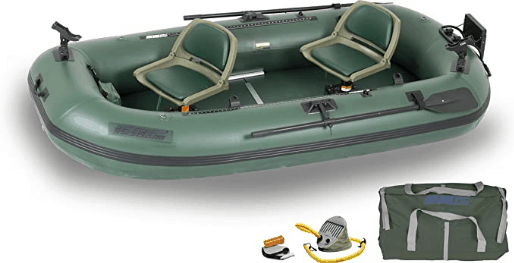
If you’re in search of the best inflatable dinghy specifically designed for the ultimate fishing experience, look no further than the Stealth Stalker STS10 by Sea Eagle. It’s difficult to find inflatables that combine the basic dinghy performance with this boat’s incredibly useful fishing features.
Instead of the usual pontoons separated at the transom, this boat has a fully enclosed hull with a wide profile. It comes with a marine-grade plywood floor and side struts that increase its overall stability. So, whether you’re fishing in saltwater or freshwater, the Stealth Stalker STS10 will perform excellently even in extreme conditions.
The boat has a frameless design that makes folding. Plus, it weighs only 45 lbs when deflated, making transportation easy for a single user.
It comes complete with several features, including fish rulers, repair kit, and a carry bag to safely stow away the boat when not in use. Fishing boats simply don’t get any more convenient than the Stealth Stalker STS10!
Specs
- Weight: 45 lbs (78 lbs with motor mount and floorboards)
- Number of Chambers: 3
- Passenger Capacity: 2 adults
- Load Capacity: 1,200 lbs
- Engine Capacity: 4 HP gas or up to 74 lb. thrust electric
- Fabric: PVC (quadruple overlapping seams)
- Warranty: 3 years (180-day return policy)
Features
- Built-in Options: Raised oarlocks, motor mount, two 360o inflatable swivel seats, and four built-in rod holders.
- Accessories: Carry bag, stow bag, oar set, two 40-inch fish rulers, A41 foot pump, and repair kit.
Pros
• Offers extreme stability
• Incredibly lightweight when deflated, making transport and storage easy
• Folds smaller than most other models when deflated
• Affordable
Cons
• Relatively low maximum horsepower rating when compared to other models
• Can be heavy for one person to carry once it is set up
• Not easy to maneuver in tight spaces
• Not suitable for general boating since the design is specifically for fishing
At this point, most people would have made up their minds about which boat is the best inflatable dinghy. While it is okay to eye one or a couple of these options, we’ll suggest that you hold off choosing for a little while until you know what to look for when choosing an inflatable dinghy.
But first, let’s see some of the advantages of buying an inflatable dinghy instead of other traditional boats.
Why You Should Buy an Inflatable Dinghy
Several types of inflatable boats are used for different purposes. This ranges from motorized inflatable pontoon boats to inflatable sport boats to rigid inflatable boats, and others. These boats have become popular for several reasons, including:
Portability
Portability is perhaps the biggest reason to invest in an inflatable dinghy. Most types can be deflated and rolled up or folded easily. Storing them doesn’t require a lot of space. You can keep them safe in your garage (off the floor). That means zero winter storage fees and absolutely no need for slip rentals. And since you can transport them in the trunk of your car, there is no need for trailers.
Of course, larger types are heavier and difficult to lug from one place to another, but they don’t require a trailer to move them.
Durability
Wait, what?
How is a “balloon” on water durable?
Inflatable dinghies are not mere balloons or rubber floating on water. Modern constructions use polyvinyl chloride (PVC) fabrics or Hypalon (a nylon neoprene-coated material) to build highly durable boats that can withstand harsh conditions and hazards, including abrasion, UV rays, and extreme temperatures.
You don’t have to worry about frequent leaks because the seams of modern inflatable dinghies are heat-welded. Purchasing an inflatable dinghy is a wise investment if you enjoy fishing or some other water activities because the boat is designed to last for several seasons.
Stability
Canoes, kayaks, and other boats in the same class do not provide the type of stability as inflatable dinghies. It is a lot safer to stand in inflatables and maneuver the boats even at high speeds, especially if you buy one with a V-shaped keel and a hard floor. If you buy a larger model, you can even use it in the ocean’s open waters.
Versatility
Many other boats are built to suit only one application. But inflatable dinghies are designed to be used under various conditions in a wide range of waterways and can be used in saltwater and freshwater.
Many inflatables also come with optional accessories, including seating, fishing rod holders, canopies, and storage.
Choosing the Best Inflatable Dinghy – Buying Guide
Here’s a quick tip when it comes to buying an inflatable that will serve you for several years: always look beyond the brand name and price tag.
Yes! Selecting a good-quality inflatable dinghy is all about choosing one with the right features for your purpose. It doesn’t matter how expensive a boat is; if it doesn’t suit your purpose and where you live or where you’ll be using it, you shouldn’t buy it.
Before you purchase a boat, we suggest that you take some time and give serious thoughts to the following.
Boat Size
Inflatables come in different sizes, and size can significantly affect performance. Choosing a size depends a lot on how you intend to use the boat. What size of motor do you want to use? How many passengers do you expect onboard on average? You should also consider the amount of gear you usually bring along and the normal conditions you expect to encounter. All these factors can impact the performance of a boat.
Generally, inflatables over 10 feet long usually offer a greater level of control. They are less likely to rock during strong wind currents and are a lot easier to plane. Of course, if you do not need that much space, there’s no need to buy a 10-feet long boat or more. But whatever you do, keep in mind that overloading your dinghy will definitely reduce its performance, regardless of the size.
Floor Type
Think about the pros and cons of flooring available in the inflatable before you buy it. Why is this important? The floor of a boat can affect its stability, speed, weight, and even performance. As you go through this section, consider where you want to use the dinghy – on choppy waters, running river, or flat water?
The four types of floors available in inflatable dinghies include:
- Slat Floors
Slat floors, also known as roll-up floors, are the most basic floors you will encounter in inflatable boats. Slat floors are made from materials such as plywood or aluminum and are easy to assemble. Storing them is as easy and rolling them up and stowing away.
If you want a simple boat that is perfect for short trips, consider one with roll-up floors such as a roll-up inflatable dinghy. They are easy to deflate, roll up, and store. They require only a small space for storage and are not expensive.
However, because the floors are not rigid, it can be difficult to stand on them. Another major downside of slat floors is that they can damage the boat’s fabric if they get broken. And since these types of dinghies don’t come with a keel, performance on the water is limited. They are most suited to small water bodies with flat water.
Consider getting another type of dinghy if you want to ride in choppy waters of the open ocean. But if you prefer a slat floor inflatable dinghy, make sure to purchase one with the slat floors close together as they are more stable than those with slats that are further apart.
- Hard Floors
Inflatables with hard floors offer more stability and rigidity and slat floor types. The floors are also made from wood or aluminum and usually come with a V-shaped keel for added rigidity. This combination allows the boat to get on a plane easily. It also improves maneuverability and overall performance on choppy waters.
Hard floor inflatables are rather stable, making them versatile as they can be used as dive boats, yacht tenders, and fishing boats.
Expect to pay more hard floored boats such as the Rigid Hull Inflatable dinghies (RHIs). Setting them up will also take a long time compared to roll-up inflatable dinghies that take less time to inflate and deflate. These boats are quite heavy, so carrying them from land to water is a bit difficult. As you probably already figure out, storing these dinghies requires considerable space because they are not as portable as other options.
Consider getting an inflatable with a hard floor if you have ample space to store them, and you don’t mind spending some time assembling the boat when you need to use it. After all, that’s a small price to pay if you want a boat that will cut through choppy waters like a hot knife slices through butter!
- Air Floors
Air floors, also known as air deck, are separate flat tubes that inflate like the rest of the dinghy. They are made from tough PVC materials and are rigid enough to stand or even jump on, but weigh less than hard floors.
Inflatable dinghies with air floors usually have keels, and this gives them superior maneuverability, and their lightweight improves their speed. The floors are comfortable for kneeling and sitting.
Air floor boats are portable and faster to assemble than hard floor boats. They also don’t require much storage space.
However, these boats don’t come cheap. Expect to spend top dollar for a good-quality air floor inflatable dinghy. But the major downside is not the price tag. Air floor boats are prone to punctures. This is probably not the best choice if you want to mount real seats or a fish finder on your boat.
Pro tip: One way to minimize piercing through the boat is to lay a piece of carpet or cut-to-shape vinyl on the floor. This is particularly helpful if you plan to carry things around in your boat or use it for fishing.
Another disadvantage of air floor boats is their weight. These boats are particularly lightweight because the floor is filled with air. While that’s a good thing, it makes them unsuitable for rough waters. Lightweight is not an advantage when it comes to stability on the water. Consider getting a heavier boat if you want more stability, especially in rough waters.
- Self-Bailing Floors
The floors in regular boats are made with sealed tubes. If water gets into the boat, it remains there until it is scooped out manually. That’s the disadvantage of non-bailing standard floors.
The solution? Self-bailing floors!
These types of floors have holes in the sides that let water out of the boat. If you are mostly using an inflatable in situations, such as white-water rafting, where lots of water can enter the cockpit, it can be extremely helpful to buy a boat with a self-bailing floor.
Boat Fabric
The type of fabric used to make a boat determines its durability and quality. The popular options when it comes to materials for inflatables are PVC and Hypalon. Both choices are durable, but with peculiarities.
PVC fabrics are synthetic plastic polymers. That means boats with these fabric types are lightweight, portable, and affordable (since the material is less expensive than the nylon-coated Hypalon). Repairing a boat made from PVC fabric is extremely easy – a tear can be glued or thermo-bonded.
However, PVC boats are not suitable for tropical locations. Excessive heat and humidity can easily damage the plastic material or harden the fabric if used under sunlight for too long. These boats have a short life circle because PVC fabrics cannot withstand abrasion for too long.
On the other hand, boats made from Hypalon can resist ultraviolet rays, extreme temperatures, abrasion, and mechanical wear and tear. This is because the material is a synthetic rubber. Repairing Hypalon fabric can be done easily by applying a patch. Overall, these boats will last longer because the material is more durable.
However, Hypalon is expensive, and as expected, the cost of an inflatable dinghy with Hypalon fabric won’t come cheap. The color can fade when left under the sun for too long.
If you live in the tropics or intend to use a boat that will not harden by being under sunlight for long hours, your best bet would be to purchase a boat made with Hypalon fabric. On the flip side, if you live in colder regions and don’t intend to be on the water for too long during sunny days, a PVC boat might suit you just fine.
Hull Type
When it comes to hull type, the best inflatable dinghy for you will depend on the activity you intend to use the boat for. Hull types include:
- Flat Hull
A boat with a flat hull doesn’t come with a keel, which means it won’t provide adequate stability. Directing and maneuvering this type of boat can be difficult. Generally, flat hull boats don’t reach high speeds and will not get on planes.
So, what are they good for? Consider getting a flat hull boat if all you do is going on short trips or you want a boat that will move slowly while you fish for a few hours.
- V Hull
A V hull boat usually comes with an inflatable keel. They are perfect for cutting through water as they can get on planes at high speeds. They offer great stability and maneuverability than flat hull types, and as you’ll expect, they are a bit more expensive, too. This boat might be just what you want if you are looking for the best inflatable dinghy that will serve as a tender during wildlife, fishing, or diving activities.
- Deep-V Hull
Deep-V hulls are common features in rigid inflatable dinghies and are quite pricey. Boats with deep-v hulls have enhanced stability, increased speed, and give more control. But because they sail higher on water due to their hull design, they can rock in the wind and even tilt.
Availability of OEM Accessories
Although you can buy a new boat after a while, wouldn’t it be better if you can save costs by simply upgrading? Adding additional storage, a canopy, or even adding a few seats might be all you need instead of buying an entirely new boat.
But you can’t upgrade easily if your boat doesn’t have readily available OEM accessories or aftermarket parts. For this reason, take some time to look around for available accessories for the inflatable dinghy you intend to purchase.
Besides, it will be helpful if the boat you choose includes accessories such as waterproof carry bags, seat cushions, paddles, and other items.
Warranty
Lastly, consider buying a boat from a manufacturer with a long-term warranty. Even if you choose the best inflatable dinghy made from durable materials, you cannot completely rule out accidental damages, so keep an eye out for a solid warranty.
Bottom Line: What is the Best Inflatable Dinghy?
As you would have deduced by now, there is no one-size-fits-all when it comes to choosing the best inflatable dinghy. What works for one person might not be suitable for another because these boats are versatile and can be used for more than one purpose.
A fisherman might not choose the same type of inflatable boat as someone who wants a sport boat. Waterways and conditions can also affect individual choice.
In a nutshell, the best inflatable dinghy is that which suits your purpose, location, and preferences. And we’re sure one or more of the options in this guide will meet your needs.
Categories: Reviews
